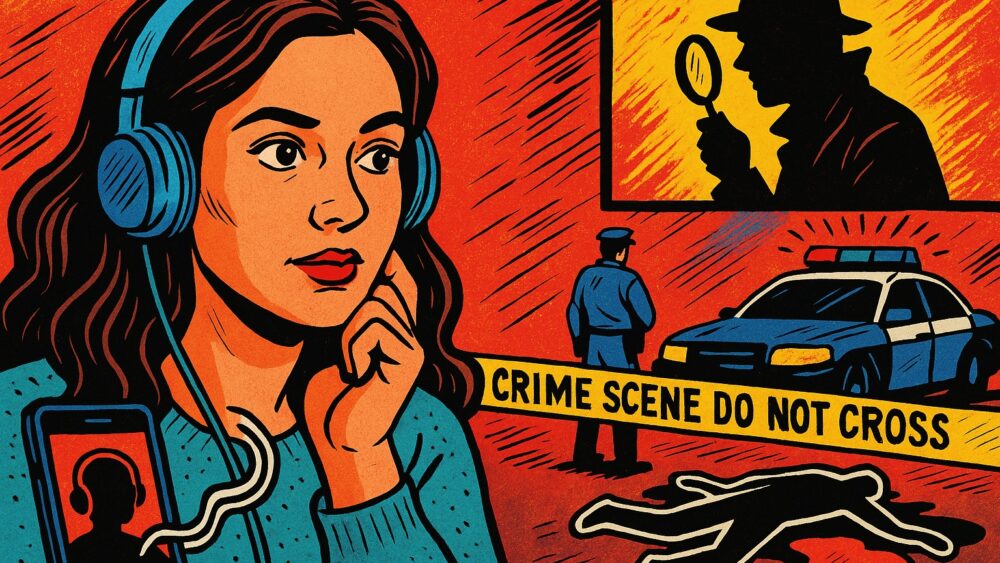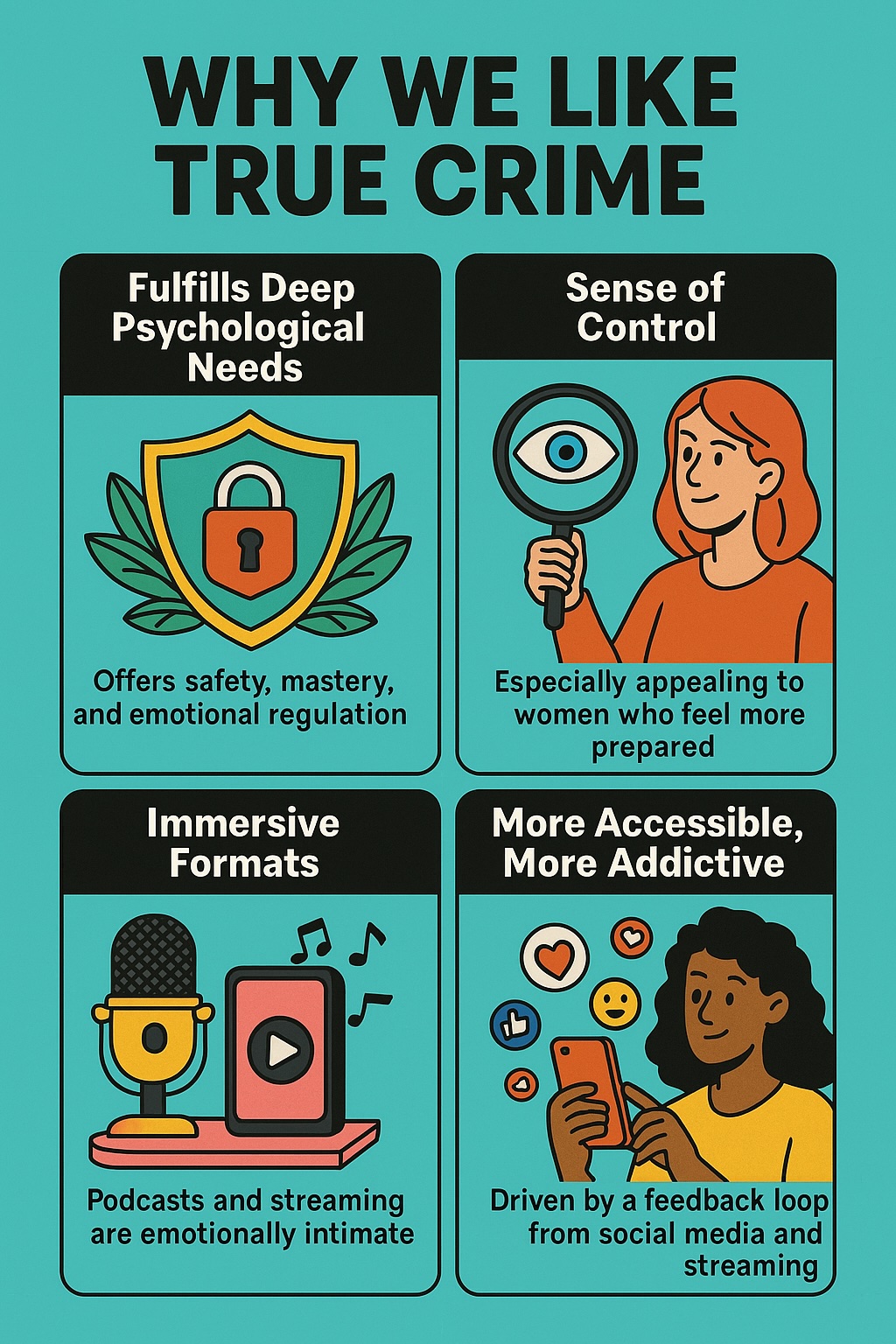True crime media isn’t just a guilty pleasure—it can fulfill deep emotional and cognitive needs, especially for women.
Key Points
- True crime media fulfills psychological needs like safety, mastery, and emotional regulation.
- Women may be especially drawn to true crime because it offers a sense of control and preparedness.
- Modern formats like podcasts and streaming create immersive, emotionally intimate experiences.
- Social media and algorithms have created a feedback loop that makes true crime more accessible and addictive.
There’s something oddly engaging about listening to a stranger’s murder while unloading the dishwasher or walking the dog. That’s not a judgment—it’s an observation. The popularity of true crime media, especially among women, has become one of the most enduring entertainment trends of the past decade. Podcasts like Crime Junkie, Morbid, and My Favorite Murder, documentaries like Making a Murderer, and dramatizations like American Murder: Gabby Petito and Monster are more than just entertainment—they’re part of how we understand the world.
True crime media has evolved from a niche curiosity to a mainstream obsession, particularly among women. Its popularity isn’t just about morbid curiosity—true crime offers insights into fear, control, emotional regulation, and human connection.
Why Women Love True Crime (and Why That Makes Sense)
True crime, often described as both frightening and comforting, presents a paradox that aligns with our lived experiences. For women, who statistically face a higher risk of violent crimes, true crime media can serve as a form of psychological rehearsal. By hearing others’ stories, they can gain a sense of control, feeling better equipped to recognize warning signs or respond to risk. This is not fear-mongering, but a form of threat management.
True crime also has a strong social dimension. Communities formed around true crime provide spaces for women to share their own stories, feel seen, and connect with others who understand. These communities offer a platform to explore vulnerability, justice, and identity, transforming true crime from mere entertainment into a tool for coping, connection, and collective healing.
Are There Psychological Benefits to True Crime?
According to theories such as Uses and Gratifications, we select media that serve specific psychological functions (Rubin, 2002). Through this lens, true crime meets several human needs:
- Understanding and mastery: Humans are storytelling creatures wired to seek patterns, motives, and closure. Crime stories offer puzzles with emotional stakes.
- Safety: Oddly enough, learning about crimes can make people feel safer. Dissecting what went wrong helps us feel more informed—and more prepared.
- Emotional regulation: True crime delivers strong emotions like fear, anger, and outrage in a structured arc, helping us manage those feelings productively.
- Social connection: Listeners often describe podcast hosts as friends. These parasocial relationships may be one-sided, but they still fulfill social needs and foster trust.
Modern Formats Enable Deeper Engagement
The format matters as much as the story. Modern true crime media, such as podcasts, streaming series, and social platforms, offer intimacy and immersion that older formats never could. These aren’t just stories; they’re shared emotional experiences, a blend of entertainment, education, and empathy.
- Streaming provides on-demand justice, emotional investment, and cinematic pacing. Bingeable series let us regulate emotions and feel a sense of control.
- Podcasts fit easily into multitasking lives and build closeness with narrators. A host’s voice in your ear creates an intimate, almost companionable experience.
- Social media transforms passive consumers into active participants. Platforms like Reddit and TikTok are filled with amateur sleuths who analyze cold cases and form global justice communities. Online fandoms foster belonging and shared identity.
- Algorithms create a self-reinforcing cycle by feeding users content that matches existing interests, increasing both engagement and emotional dependency.
True Crime at the Tipping Point: Fascination or Fatigue?
True crime isn’t going away, but have we reached a point of over-saturation? The genre’s ubiquity has raised growing concerns, both ethical and psychological.
- Being a true crime enthusiast can also have negative effects. Cognitive biases and repeated exposure to emotionally intense narratives can lead to beliefs that the world is more dangerous than it actually is (Gerbner & Gross, 1976). This can lead to overestimating personal risk, reduced trust in strangers or institutions, and chronic hyper-vigilance or anxiety. Even in the face of declining crime rates, true crime content can create perceptions of increased threat. Algorithm-driven platforms widen this gap, reinforcing fear-based narratives.
- As true crime content floods podcasts, streaming platforms, and social media feeds, the line between storytelling and sensationalism has become dangerously blurred. A lot of money is made from dramatized “documentaries” that are often heavily scripted and stylized; the viewer is left with little ability to distinguish fact from fiction. These blurred lines can desensitize audiences to real-life atrocities, shifting the focus from justice and truth to the pursuit of entertainment value. In the pursuit of gripping narratives, respect and empathy for victims can get lost.
- The glorification of criminals, some of whom are elevated to near-celebrity status, can undermine public understanding of crime as harmful and traumatic, perpetuate harmful myths, bias juries, and reduce the likelihood of impartial justice.
- High consumption of true crime fuels a culture of online speculation. Social media platforms can become echo chambers for “armchair detectives,” who may inadvertently disrupt legal proceedings or bias public opinion, including that of potential jurors. These ripple effects underscore how media narratives can shape into real-world consequences.
Ethical Approaches to True Crime
As true crime continues to gain popularity, there are growing voices for more ethical approaches that prioritize victims, justice, and systemic accountability. This shift can build audience awareness, help promote empathy for victims, and encourage more responsible consumption of true crime content. Call it true crime literacy.
TikTok and Reddit communities were vocal in their criticism of shows like Dahmer – Monster: The Jeffrey Dahmer Story for exploiting victim trauma without family consent. Podcasts such as Crime Junkie and My Favorite Murder have faced community backlash, and lost listeners to more respectful and accurate programs, for failing to cite sources or for joking about real victims. A 2024 YouGov poll found that over 60% of U.S. adults believed creators should get consent from victims and their families before producing content.
Still, sensationalism remains a powerful force. Emotionally charged content is more memorable and more clickable, often overshadowing more balanced, investigative reporting. True crime content also tends to spike during times of political or social instability. Crime programming surged in the late 1960s as Americans sought to make sense of growing violence and uncertainty, turning crime narratives into a lens for understanding societal breakdown (Dominick, 1973).
Perhaps it’s no surprise we’re seeing it grow in popularity now, given the amount of social and political conflict in the last decade. True crime narratives can be an antidote by following a reassuring arc, with the promise of justice and resolution. When real-world systems feel chaotic or unjust, these stories offer a sense of closure, moral clarity, control, and a little escapism—an antidote to the ambiguity of everyday life.
More than Sensationalism?
True crime reflects how people seek meaning, manage fear, and build emotional resilience. It can fulfill needs for safety, understanding, and belonging. But like any media, it’s worth pausing to ask yourself: Is my true crime consumption contributing to my well-being and emotional health, or is it making the world seem scarier?
References
Dominick, J. R. (1973). The portrayal of crime and law enforcement on television. Public Opinion Quarterly, 37(2), 241–250. https://doi.org/10.1086/268081
Gerbner, G., & Gross, L. (1976). Living with television: The violence profile. Journal of Communication, 26(2), 172–199.
Horeck, T. (2019). Justice on Demand: True Crime in the Digital Streaming Era. Wayne State University Press.
Rubin, A. M. (2002). The uses-and-gratifications perspective of media effects. In J. Bryant & D. Zillmann (Eds.), Media effects: Advances in theory and research (2nd ed., pp. 525–548). Lawrence Erlbaum Associates.
YouGov. (2024). YouGov Survey: True Crime. ygo-assets-websites-editorial-emea.yougov.net


 Dr. Pamela Rutledge is available to reporters for comments on the psychological and social impact of media and technology on individuals, society, organizations and brands.
Dr. Pamela Rutledge is available to reporters for comments on the psychological and social impact of media and technology on individuals, society, organizations and brands.